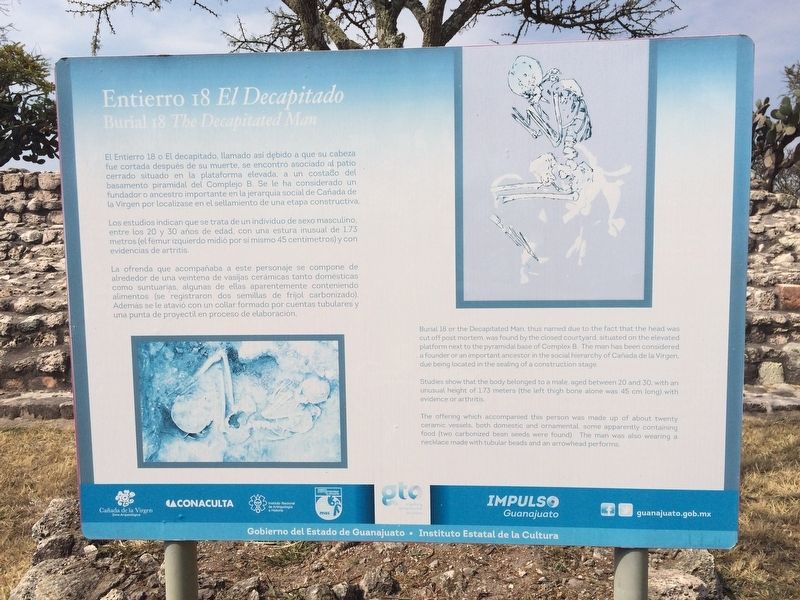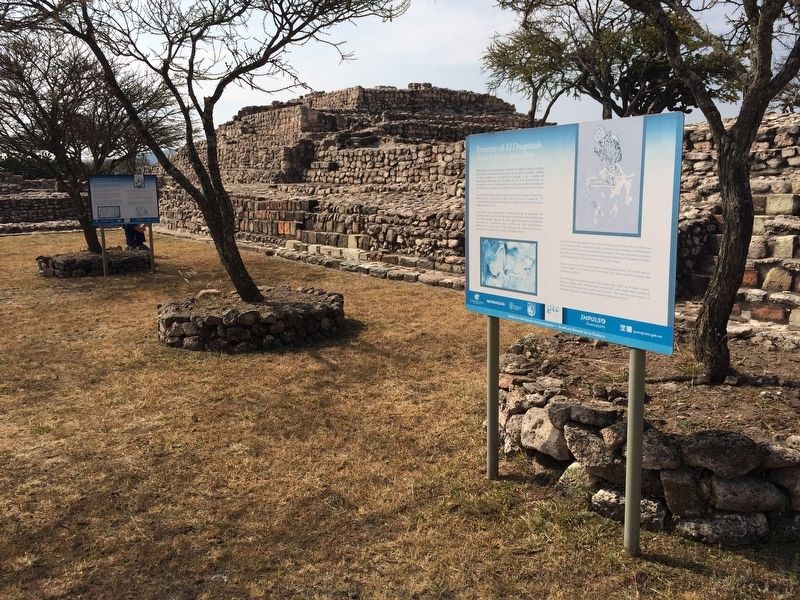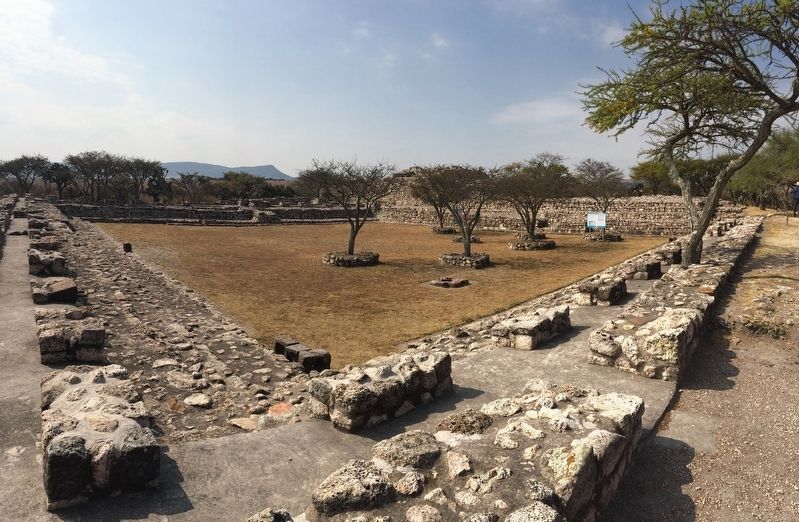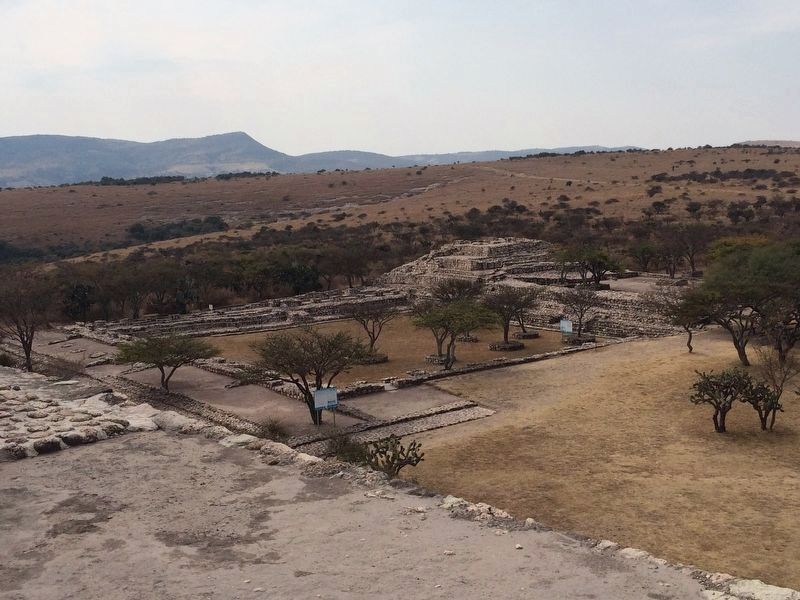Near San Miguel de Allende, Guanajuato, Mexico — The Central Highlands (North America)
Burial 18 The Decapitated Man
Entierro 18 El Decapitado
El Entierro 18 o El decapitado, llamado así dębido a que su fue cortada después de su muerte, se encontró asociado al patio cerrado situado en la plataforma elevada, a un costado del basamento piramidal del Complejo B. Se le ha considerado un fundador o ancestro importante en la jerarquia social de Cañada de la Virgen por localizase en el sellamiento de una etapa constructiva.
Los estudios indican que se trata de un individuo de sexo masculino, entre los 20 y 30 años de edad, con una estura (sic, estatura) inusual de 1.73 metros (el fémur izquierdo midió por sí mismo 45 centímetros) y con evidencias de artritis.
La ofrenda que acompañaba a este personaje se compone de alrededor de una veintena de vasijas cerámicas tanto domésticas como suntuarias, algunas de ellas aparentemente conteniendo alimentos (se registraron dos semillas de frijol carbonizado). Además se le atavió con un collar formado por cuentas tubulares y una punta de proyectil en proceso de elaboración.
English:
Burial 18 The Decapitated Man
Burial 18 or the Decapitated Man, thus named due to the fact that the head was cut off post mortem, was found by the closed courtyard, situated on the elevated platform next to the pyramidal base of Complex B. The man has been considered a founder or an important ancestor in the social hierarchy of Cañada de la Virgen, due being located in the sealing of a construction stage.
Studies show that the body belonged to a male, aged between 20 and 30, with an unusual height of 1.73 meters (the left thigh bone alone was 45 cm long) with evidence or arthritis.
The offering which accompanied this person was made up of about twenty ceramic vessels, both domestic and ornamental, some apparently containing food (two carbonized bean seeds were found). The man was also wearing a necklace made with tubular beads and an arrowhead performs (sic, in the process of being made).
Erected by Consejo Nacional para la Cultura y las Artes de México (CONACULTA)-INAH.
Topics. This historical marker is listed in these topic lists: Anthropology & Archaeology • Man-Made Features • Native Americans.
Location. 20° 51.464′ N, 100° 55.747′ W. Marker is near San Miguel de Allende, Guanajuato. Marker can be reached from Route 67. The marker is at the southern plaza of the archaeological site of Cañada de la Virgen. The site is to the left when traveling north on State Road 67, some 30 km west of San Miguel de Allende. Touch for map. Marker is in this post office area: San Miguel de Allende GTO 37701, Mexico. Touch for directions.
Other nearby markers. At least 8 other markers
are within walking distance of this marker. Complex B: The House of the Longest Night (within shouting distance of this marker); Burial 13 The hierarch and ancestral veneration (within shouting distance of this marker); Layout and Architecture (about 90 meters away, measured in a direct line); Observing the Stars (about 120 meters away); Complex D. The wind house. (The house of the wind) (about 150 meters away); Complex A The House of the Thirteen Heavens (about 150 meters away); Cañada de la Virgen: A Ceremonial Civic Center in the Laja River Basin Marker (about 210 meters away); Ceremonial Road (approx. 0.2 kilometers away). Touch for a list and map of all markers in San Miguel de Allende.
Additional keywords. Burial 18 The Decapitated Man
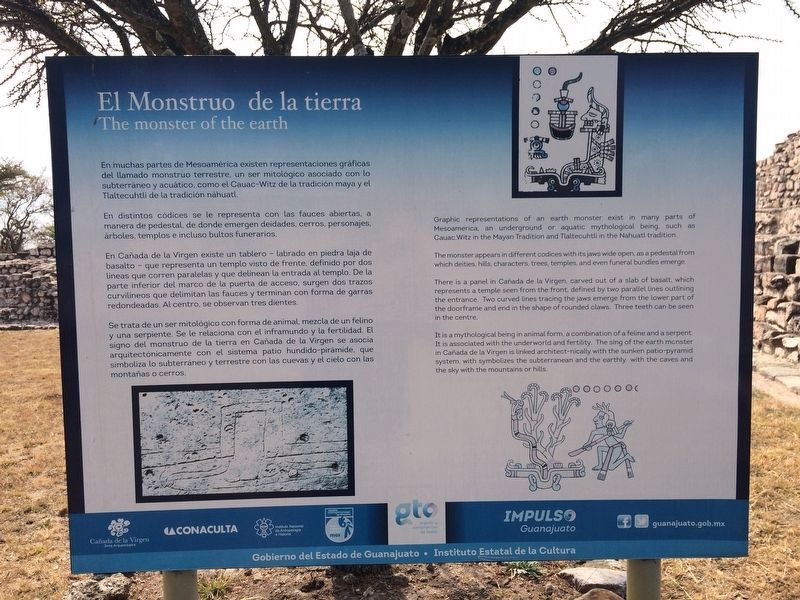
Photographed By J. Makali Bruton, February 5, 2017
4. The nearby The Monster of the Earth Marker
El Monstruo de la Tierra
En muchas partes de Mesoamérica existen representaciones gráficas del llamado monstruo terrestre, un ser mitológico asociado con lo subterráneo y acuático, como el Cauac-Witz de la tradición maya y el Tlaltecuhtli de la tradición náhuatl.
En distintos códices se le representa con las fauces abiertas, a manera de pedestal, de donde emergen deidades, cerros, personajes, árboles, templos e incluso bultos funerarios.
En Cañada de la Virgen existe un tablero - labrado en piedra laja de basalto que representa un templo visto de frente, definido por dos líneas que corren paralelas y que delinean la entrada al templo. De la parte inferior del marco de la puerta de acceso, surgen dos trazos curvilíneos que delimitan las fauces y terminan con forma de garras redondeadas. Al centro, se observan tres dientes.
Se trata de un ser mitológico con forma de animal, mezcla de un felino y una serpiente. Se le relaciona con el inframundo y la fertilidad. El signo del monstruo de la tierra en Cañada de la Virgen se asocia arquitectónicamente con el sistema patio hundido-pirámide, que simboliza lo subterráneo y terrestre con las cuevas y el cielo con las montañas o cerros.
English:
The monster of the earth
Graphic representations of an earth monster exist in many parts of Mesoamerica, an underground or aquatic mythological being, such as Cauac Witz in the Mayan Tradition and Tlaltecuhtli in the Nahuatl tradition.
The monster appears in different codices with its jaws wide open, as a pedestal from which deities, hills, characters, trees, temples, and even funeral bundles emerge.
There is a panel in Cañada de la Virgen, carved out of a slab of basalt, which represents a temple seen from the front, defined by two parallel lines outlining the entrance. Two curved lines tracing the jaws emerge from the lower part of the doorframe and end in the shape of rounded claws. Three teeth can be seen in the centre.
It is a mythological being in animal form, a combination of a feline and a serpent. It is associated with the underworld and fertility. The sing (sic, sign) of the earth monster in Cañada de la Virgen is linked architect-nically with the sunken patio-pyramid system, with symbolizes the subterranean and the earthly with the caves and the sky with the mountains or hills.
Credits. This page was last revised on September 1, 2020. It was originally submitted on June 6, 2017, by J. Makali Bruton of Accra, Ghana. This page has been viewed 139 times since then and 15 times this year. Photos: 1, 2, 3, 4, 5. submitted on June 6, 2017, by J. Makali Bruton of Accra, Ghana.
